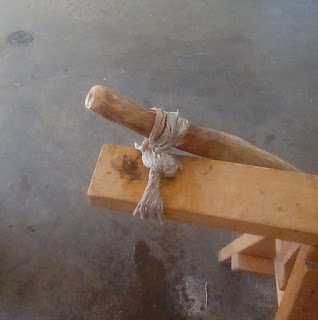Shooting a Center Cut Bow with the Arrow on the Inside
You will have to switch your common bow hands; thus, the technique will initially feel awkward and quite difficult, however with time, building the requisite musculature, this method of shooting will work.
There some advantages to firing a shaft from the outside as apposed to the inside of the bow. While hunting, this method makes it possible to nock the arrow quickly.
When I practice shooting using this method, I pull the string with my middle finger and ring finger, and use my index finger to keep a light pressure on the shaft so it will stay on the string and shelf through the draw; this method is commonly referred to as the Slavic Draw. I use a straight, strong shaft with a extra broad knock and reinforce the knock with sinew.
If you use this type of draw to, you will also need to fletch 2.25” to 3” forward of the nock, as your index finger on your fletching will "scrunch" them and have a detrimental effect on their guide.
I cant comment on using a thumb release, nor can I explain exactly what YOU should be doing with your bow hand - as with most things, don't do exactly what a teacher or coach tells you to do: do what works for you; but, as I use the Slavic style release, for the arrow-on-the-outside, I need to add an important, controlled, bow hand movement, which moves the shelf and bow out of way; a forward, to the right, and thrust downward of the top limb, powered from my whole arm, including my wrist; this may be better explained in the arrow spur; if I don't the fletch will catch the shelf or bow stave and fish tail down range. What is most important is to have a strong and controlled bow hand.
To expand, the bow hand movement is not flicking or flinging of the shaft; it's a controlled movement away from the exiting rear of the arrow; this seems strange, as, if the center cut bow where used in the traditional "style" or western style, you would typically knock and just let the bow do what it do.
If you use this type of draw to, you will also need to fletch 2.25” to 3” forward of the nock, as your index finger on your fletching will "scrunch" them and have a detrimental effect on their guide.
I cant comment on using a thumb release, nor can I explain exactly what YOU should be doing with your bow hand - as with most things, don't do exactly what a teacher or coach tells you to do: do what works for you; but, as I use the Slavic style release, for the arrow-on-the-outside, I need to add an important, controlled, bow hand movement, which moves the shelf and bow out of way; a forward, to the right, and thrust downward of the top limb, powered from my whole arm, including my wrist; this may be better explained in the arrow spur; if I don't the fletch will catch the shelf or bow stave and fish tail down range. What is most important is to have a strong and controlled bow hand.
To expand, the bow hand movement is not flicking or flinging of the shaft; it's a controlled movement away from the exiting rear of the arrow; this seems strange, as, if the center cut bow where used in the traditional "style" or western style, you would typically knock and just let the bow do what it do.
Keep in mind, that doing this incorrectly, by torqueing the bow while drawn too much, in anticipation of the release, can accelerate wear on the bow.
If shooting the center cut bow, with a traditional two under and one over style of release, the archers paradox, with a properly spined arrow, tends to allow the shaft to leave the bow without rubbing against the shelf, using a typical straight arm and no movement of the stave or bow arm; when you switch your hands to shoot the arrow on the outside of the bow and draw my way, you must add the steps mentioned above to not only move the bow out of the way of the exiting shaft (which will "slap" due to a reverse "archers paradox" effect), but also to have a smooth release that reduces hand shock, stress on the string, and thus transfer more energy to the shaft.
Accuracy and arrow flight, be it true or fish tailing, has near everything to do with your bow hand skill and little to do with the fletching.
If you can imagine a modern compound bow with a "drop-away" rest; these bows are designed to be the highly efficient at "transferring kinetic energy " ; and this is too your goal by beginning to practice said "dynamic" bow hand while doing "traditional" archery and shooting on the outside. To extended the "power point" (the location the nock of the arrow sits on the string) as far and strate as possible while not interrupting the movement of the exiting shaft with the bow stave.
With time, your muscles will strengthen, and you will learn just how much movement of the bow hand is desired and required to have a true shot at your target.
Accuracy and arrow flight, be it true or fish tailing, has near everything to do with your bow hand skill and little to do with the fletching.


